
Herring are forage fish, mostly belonging to the family of Clupeidae.
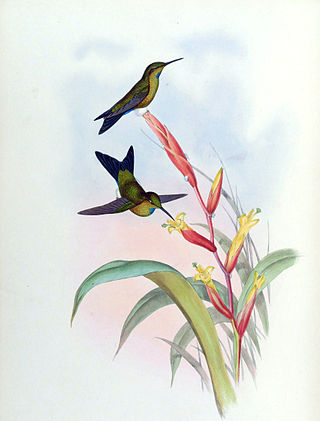
The turquoise-throated puffleg, also known as Godin's puffleg, is a species of hummingbird from Ecuador. It is mostly green with blue undertail coverts and white powder-puffs of downy feathers on the legs, and the male has a bluish-purple throat patch. It is only known from a few specimens taken in the nineteenth century and its taxonomic position is unclear. The type of habitat in which the type species was obtained has largely disappeared, and recent surveys trying to find this bird have failed. The International Union for Conservation of Nature believes it may be extinct, but there is a possibility that some individuals remain, so the bird has been rated as "critically endangered".
Cynometra vestita is a species of plant in the family Fabaceae. It is a tree found only in Fiji, on the islands of Viti Levu and Vanua Levu.
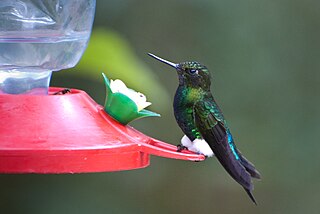
The glowing puffleg is a species of hummingbird in the "brilliants", tribe Heliantheini in subfamily Lesbiinae. It is found in Colombia, Ecuador, Peru, and Venezuela.
Basselinia vestita is a species of flowering plant in the family Arecaceae. It is found only in New Caledonia.
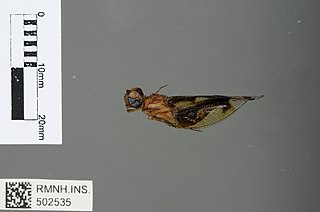
Palpopleura albifrons is a species of dragonfly in the family Libellulidae. It is endemic to Gabon. Its natural habitat is subtropical or tropical moist lowland forests.
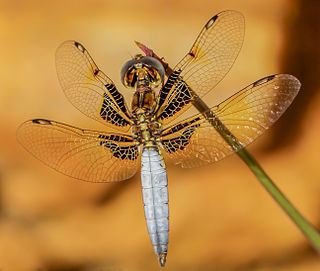
Palpopleura is a genus of dragonflies in the family Libellulidae. Five species are native to sub-Saharan Africa, one ranges widely in southern Asia, and one is a widespread endemic to Madagascar.
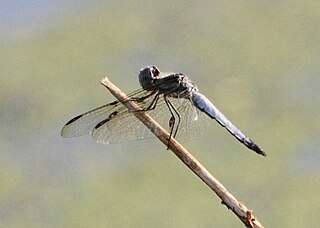
Palpopleura deceptor, the deceptive widow, is a species of dragonfly in the family Libellulidae. It is found in Benin, Botswana, Burkina Faso, Cameroon, Chad, the Democratic Republic of the Congo, Ivory Coast, Ethiopia, Gambia, Ghana, Guinea, Kenya, Malawi, Mozambique, Namibia, Niger, Nigeria, Sierra Leone, Somalia, South Africa, Sudan, Tanzania, Togo, Uganda, Zambia, Zimbabwe, and possibly Burundi. Its natural habitats are subtropical or tropical moist lowland forests, dry savanna, moist savanna, subtropical or tropical dry shrubland, subtropical or tropical moist shrubland, subtropical or tropical seasonally wet or flooded lowland grassland, swamps, intermittent freshwater lakes, and intermittent freshwater marshes.

Palpopleura jucunda, commonly known as the yellow-veined widow, is a species of dragonfly in the family Libellulidae, which is native to sub-Saharan Africa.
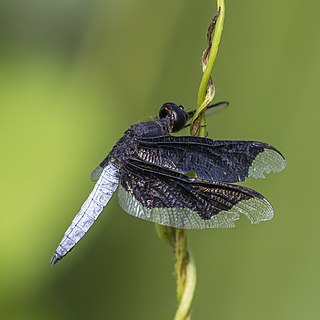
Palpopleura lucia, the Lucia widow, is a species of dragonfly in the family Libellulidae. It is found in Angola, Benin, Botswana, Burkina Faso, Cameroon, Central African Republic, Chad, Comoros, the Democratic Republic of the Congo, Ivory Coast, Equatorial Guinea, Ethiopia, Gabon, Gambia, Ghana, Guinea, Kenya, Liberia, Madagascar, Malawi, Mozambique, Namibia, Nigeria, São Tomé and Príncipe, Sierra Leone, Somalia, South Africa, Sudan, Tanzania, Togo, Uganda, Zambia, Zimbabwe, and possibly Burundi. Its natural habitats are subtropical or tropical moist lowland forests, subtropical or tropical dry shrubland, rivers, intermittent rivers, shrub-dominated wetlands, swamps, freshwater lakes, intermittent freshwater lakes, freshwater marshes, intermittent freshwater marshes, and freshwater springs.

Palpopleura portia, the portia widow, is a species of dragonfly in the family Libellulidae. It is found in Angola, Botswana, Burkina Faso, Central African Republic, the Democratic Republic of the Congo, Ivory Coast, Equatorial Guinea, Ethiopia, Gambia, Kenya, Madagascar, Malawi, Mozambique, Namibia, Nigeria, Senegal, Somalia, South Africa, Sudan, Tanzania, Togo, Uganda, Zambia, Zimbabwe, and possibly Burundi. Its natural habitats are dry savanna, moist savanna, subtropical or tropical dry shrubland, subtropical or tropical moist shrubland, rivers, intermittent rivers, shrub-dominated wetlands, swamps, freshwater lakes, intermittent freshwater lakes, freshwater marshes, intermittent freshwater marshes, and freshwater springs.
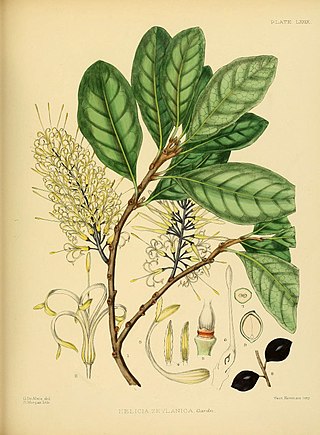
Helicia is a genus of 110 species of trees and shrubs, constituting part of the plant family Proteaceae. They grow naturally in rainforests throughout tropical South and Southeast Asia, including India, Sri Lanka, Indochina, Peninsular Malaysia to New Guinea and as far south as New South Wales.
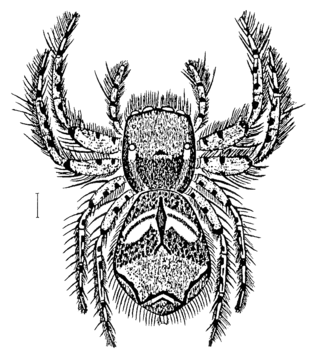
Servaea vestita is a species of jumping spider from Australia. It is found in Queensland, New South Wales and Tasmania.
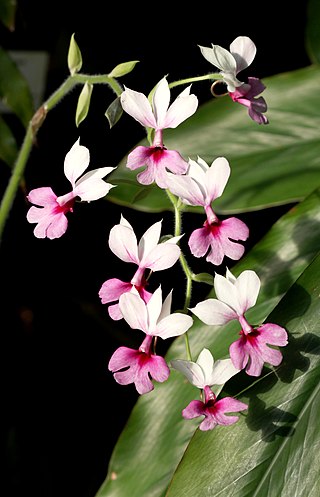
Calanthe vestita is a species of orchid. It is widespread throughout much of Southeast Asia from Assam to New Guinea including Thailand, Indonesia, Malaysia and the Philippines.

Halesia carolina, commonly called Carolina silverbells or little silverbells, is a species of flowering plant in the family Styracaceae, native to the southeastern United States.

Palpopleura sexmaculata, commonly known as the Asian widow or blue-tailed yellow skimmer, is a species of dragonfly in the family Libellulidae. It is widespread in several countries in South, East and Southeast Asia, but is no longer believed to occur in Sri Lanka.
Pentachlaena vestita is a plant in the family Sarcolaenaceae. It is endemic to Madagascar. The specific epithet vestita means 'blanketed', referring to the hairy indument on the underside of the leaves and also on stems, fruits and other surfaces.
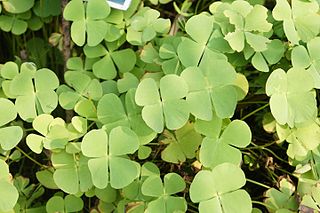
Marsilea minuta, or dwarf waterclover is a species of aquatic fern in the family Marsileaceae. It is not to be confused with Marsilea minutaE.Fourn. 1880, which is a synonym for Marsilea vestita. Other common names include gelid waterklawer, small water clover, airy pepperwort, and pepperwort, though the lattermost also applies to plants in the genus Lepidium. In French it is called marsilea à quatre feuilles and petite marsilée, the latter appearing to be a calque with the Latin botanical name. In Chinese it is 南国田字草, literally "southern field word grass," referencing the similarity of the leaflet shape to the Chinese character for "field." The Koch Rajbongshi people and Garo people call it shusni shak. It is called 'শুশনি শাক' in Bengali. In parts of India it can be called sunisanakka In Indonesian it is semanggi, but this name also applies to Marsilea crenata. In Japanese it is nangokudenjiso and in Thai it is phakwaen. In Malaysian it is tapak itik. In the Philippines it is kaya-kayapuan.
Sebastiania vestita is a species of flowering plant in the family Euphorbiaceae. It was described in 1874. It is native to Minas Gerais, Brazil.

Duvalia vestita is a small succulent plant species, in the family Apocynaceae, indigenous to the southernmost part of the Western Cape Province, South Africa.


















